 |

Kerala Tour with Gallery |
 |
 |

Kerala Tour with Gallery |
 |
|
|
|
|
|
|
|
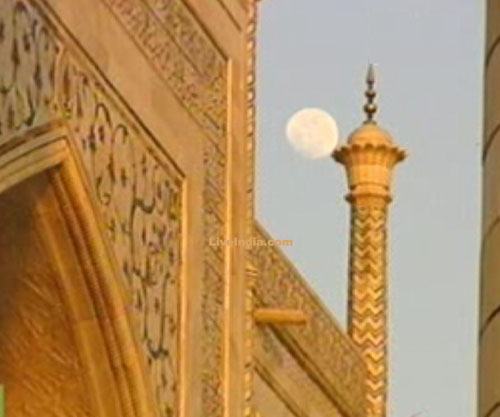
Taj Mahal Morning |
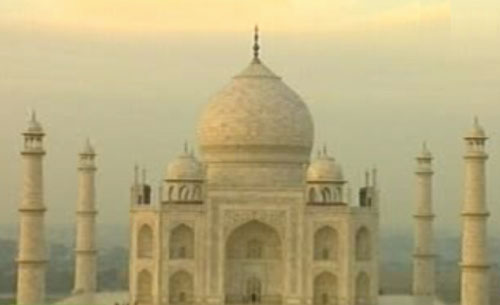
Taj Mahal Morning |
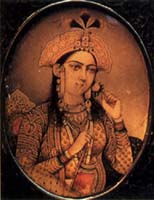
Mumtaz Mahal |
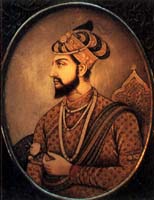
Prince Khurram |
| Prince
Khurram, who would become Shah Jahan, was born in India in the same month
as the Prophet Mohammed in the auspicious year 1,000 of the Islamic calendar
(January 15, 1592). He was named Khurram, which means "joyous," by his
doting grandfather Akbar, who said the birth made the world glad. "He was
born during the height of Akbar's power," says art historian Shobita Punja,
"when most of India came under Mughal rule. He was very well educated,
had brilliant teachers, and was quite an aesthete. He really was a very
cultured human being."
According
to one of the youth's companions at court, Prince Khurram was a handsome
youth, "possessed of a sharp wit, a wonderful memory, a love for details
and the capacity to master them." Legend has it that the young prince charmed
Arjumand Banu Begum (later named Mumtaz Mahal) at the Royal Meena Bazaar
during the Moslem New Year festival, where merchants brought fine cloth,
precious jewels and other goods for the harem and nobles of the court
"Royal women were kept in seclusion, but that has nothing to do with the power they held," adds Beach. "They clearly were extremely powerful. Shah Jahan's father, Jahangir, married a woman named Nur Jahan who was really the person who ran the empire for the second half of Jahangir's reign, when he became addicted to opium and alcohol. He barely functioned as an emperor, and she ran the country." "We know very little about Mumtaz Mahal except that she was the daughter of Asaf Khan, who was the Prime Minister for Shah Jahan and son of the Prime Minister for Jahangir whose sister, Nur Jahan, married Jahangir. You cannot be more closely related to the Imperial family than that. Many of Asaf Khan's cousins and other relatives were also placed in positions of enormous power in the Mughal court. So Mumtaz Mahal probably had a very important and influential role in her husband's life." Before
marriage to Mumtaz Mahal, the Emperor Jahangir had arranged two other marriages
for his son for political purposes. But although Shah Jahan had three regular
wives, Mumtaz Mahal became his favorite and bore his only children. The
Prince would not part with her even on his numerous military campaigns.
In his suffering, she sustained him; in his glory, she inspired him to
acts of charity and benevolence. Both comrade and counselor, she was beloved
by him for her unswerving loyalty and by his people for her wise and compassionate
guidance.
|
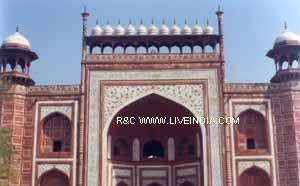
PHOTOGRAPH BY : RAJESH CHOPRA Main Entrance Gate Of The Taj Mahal |
Agra,
once the capital of the Mughal Empire during the 16th and early 18th centuries,
is two and a half hours by express train from New Delhi. Tourists from
all over the world visit Agra not only to see the ruins of the red
sandstone fortress built by the Mughal emperors but to make a pilgrimage
to Taj Mahal, India's most famous architectural wonder. In a land where
magnificent temples and edifices abound to remind visitors about the rich
civilization of a country that is slowly but surely lifting itself into
an industrialized society.
The postcard picture of Taj Mahal falls short to convey the legend, the poetry and the romance that shroud what Rabindranath Tagore calls "a teardrop on the cheek of time". Taj Mahal means "Crown Palace" and is in fact the most well preserved and architecturally beautiful tomb in the world. It is best described by an English poet, Sir Edwin Arnold, as "Not a piece of architecture, as other buildings are, but a proud passion of an emperors love wrought in living stones." It is a celebration of woman's love, exquisitely potrayed in marble. And that's the way to appreciate it ! |
|
Taj
Mahal stands on the bank of River Yamuna, which otherwise serves as a wide
moat defending the Great Red Fort of Agra, the centre of the Mughal empire
until they moved their capital to Delhi in 1637. It was built by the fifth
Mughal emperor, Shah Jahan in 1631 in the memory of his second wife, Mumtaz
Mahal, a Muslim Persian princess. She died while accompanying her husband
in Behrampur in a campaign to crush a rebellion, after giving birth to
their 14th child. Her death so crushed the emperor that all his hair and
beard were said to have grown snow white in a few months.
When Mumtaz Mahal was still alive, she extracted four promises from the emperor: first, that he build the Taj; second, that he should marry again; third, that he be kind to their children; and fourth, that he visit the tomb on her death anniversary. He kept the first and second promises. Construction began in 1631 and was completed in 22 years. Twenty thousand people were deployed to work on it. It was designed by the Iranian architect Istad Usa and it is best appreciated when the architecture and its adornments are linked to the passion that inspired it. It is a "symbol of eternal love" |
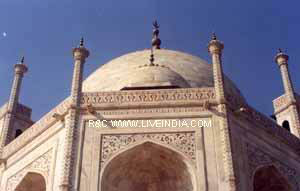
PHOTOGRAPH BY : RAJESH CHOPRA |
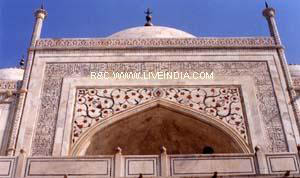
PHOTOGRAPH BY : RAJESH CHOPRA |
Having
buried her down at Behrampur, it was time for the emperor to keep his promise
and build a tomb there itself. But by and by , it was felt that it
was virtually impossible to transfer all the marble there, as it would
cost an entire fortune and an entire lifetime. So, when Agra was chosen
as the only alternative, astonishingly her grave was uprooted and brought
to Agra, only to be finally transferred to the monument, completed twenty
two years later.
The Taj rises on a high red sandstone base topped by a huge white marble terrace on which rests the famous dome flanked by four tapering minarets. Within the dome lies the jewel inlaid cenotaph of the queen. So exquisite is the workmanship that the Taj has been described as " designed by giants and finished by jewellers". The only asymmetrical object in the Taj is the casket of the emperor which was built beside the queens, as an afterthought. The emperor was deposed by his son and imprisoned in the Great Red Fort for eight years but was later buried in the Taj. During his imprisonment he was barred from visiting Taj. What he could have was just a little view of Taj in a reflection of a diamond. |
|
As
a tribute to a beautiful woman and as a monument for enduring love, the
Taj reveals its subtleties when one visits it without being in a hurry.
The rectangular base of Taj is in itself symbolic of the different sides
from which to view a beautiful woman. The main gate is like a veil to a
woman's face which should be lifted delicately, gently and without haste
on the wedding night. In indian tradition the veil is lifted gently to
reveal the beauty of the bride. As one stands inside the main gate of Taj,
his eyes are directed to an arch which frames the Taj.
The dome is made of white marble, but the tomb is set against an awesome backdrop of the river and it is this background that works its magic of colours through their reflection and transforms the view of the Taj. The colours change at different hours of the day and during different seasons. Like a jewel, the Taj sparkles in moonlight when the semi-precious stones inlaid into the white marble on the main mausoleum catch the glow of the moon. The Taj is pinkish in the morning, milky white in the evening and golden when the moon shines. These changes, they say, depict the different moods of woman. Different people have different views of the Taj but it would be enough to say that the Taj has a life of its own that leaps out of marble, provided you understand that it is a monument of love. As an architectural masterpiece, nothing could be added or subtracted from it. |
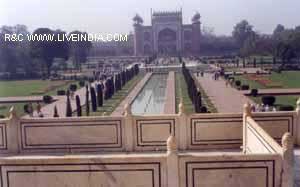
PHOTOGRAPH BY : RAJESH CHOPRA View of entrance gate from Taj Mahal |
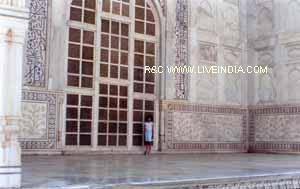
PHOTOGRAPH BY : RAJESH CHOPRA |
Trivia :- Mumtaj Begam (Arjumn Banu )
was the niece of Noorjahan ( Mehrunisa), who in turn was niece of Akbar's Persian (Iran) queen Bilgis Begam p.'s. the Taj is closed on Monday Timings: 6.00 a.m - 7.00 p.m (Saturday - Thursday) Closed on Fridays and public holidays |
Agra
by Air
Agra
by Road
Agra
by Rail
Location of Agra Taj
Mahal is located in the city of Agra, one of the most powerful cities in
the medieval world. Agra is a part of the state of Uttar Pradesh, in the
northern region of India. It is a part of the great northern plains and
is situated on the west bank of river the Yamuna. Agra is 204 km south
of Delhi.
|
| Picture Gallery |
|
|
Fatehpur Sikri | Home |
 |
 |
 |

 |
 |
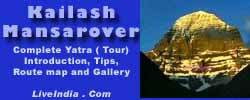 |
 |
 |
 |
| Google+ |
|
|
|
|
| Privacy Policy for LiveIndia.Com |